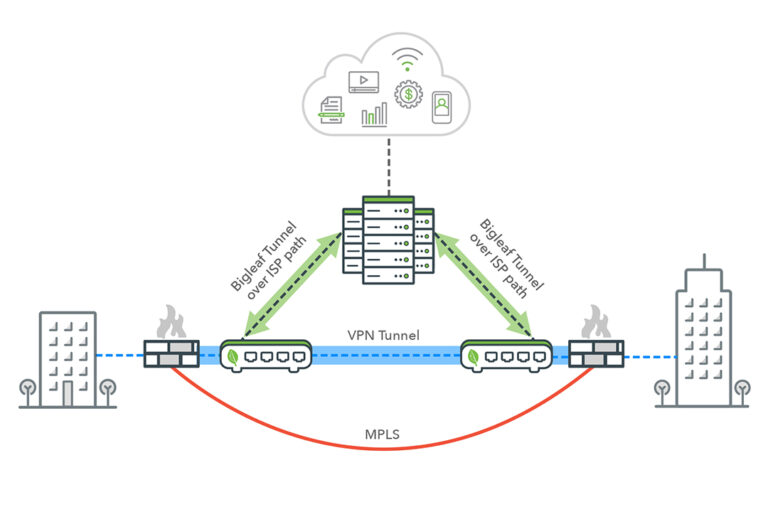
Bigleaf and MPLS
Optimizing your internet connectivity with Bigleaf while leveraging your MPLS connection
A very common question we hear from our partners and customers is whether Bigleaf’s service “works with MPLS.” The simple answer is “yes,” but the “when” and “how” components deserve some explanation. While Bigleaf is typically used as a replacement for MPLS, you can create a hybrid setup while you wait for your MPLS contract to run out and still leverage the use of that connection, or you simply want to keep an MPLS connection (or Layer 2/private line circuit) in your network.
Traditional Bigleaf model
Under Bigleaf’s traditional model, our customer premise router connects up to four Internet circuits. We encapsulate the customer’s traffic within tunnels across those Internet circuits that connect to Bigleaf’s redundant network of server clusters sitting in major peering centers across the country. Our router clusters then pass the customer’s traffic out to its destination (Google, VoIP Provider, etc.).
Internet and MPLS
For a customer who has previously invested in an MPLS network to connect multiple office locations, the question then becomes whether a location’s MPLS circuit can be utilized as a “2nd Internet” connection with Bigleaf’s service. And the answer is absolutely.
To set this up, you would have your MPLS circuit routing between your two sites via your firewall, add a Bigleaf device at each location, then create a VPN tunnel between the two sites. While you could just add Bigleaf to one site, we recommend it on both so we can protect and monitor that VPN traffic on the entire path between your sites.
In this setup, your firewalls will be doing the routing for both your site-to-site local traffic and your internet-based traffic. In this diagram below, we are showing the MPLS set up as a primary path for site-to-site traffic; however, it could instead be set as the backup.

Note, the reason MPLS is not connected through the Bigleaf router is because Bigleaf needs an internet connection so we can create our tunnel between our gateways and POPs.
On the LAN side of the equation
You do have configuration options:
Option #1: Connect your sites with your MPLS via your firewall + connect your site(s) to the Internet with Bigleaf
Configure to send Internet traffic through the Bigleaf system and MPLS traffic straight to the MPLS router. Your Internet traffic performance will be optimized by Bigleaf and your MPLS traffic will be steered directly to your MPLS network via your firewall/router.
Option #2: Add Bigleaf to each of your sites to create a VPN + use your MPLS as your site-to-site backup connection
This option applies if you want to eventually replace your MPLS network with a VPN connectivity solution. In this case, set up your firewall to send all traffic through Bigleaf’s system. Bigleaf then becomes the transport mechanism for both your Internet traffic and VPN connectivity traffic, and your MPLS connection becomes a backup path via the firewall/router.
This is a great way to leverage an MPLS network while it’s still under contract with your carrier if you want to migrate immediately to a VPN solution.
If you have any questions or would like to talk live to learn more about how we can work together to build more robust cloud connectivity solutions, please contact us. We’re here to help!







